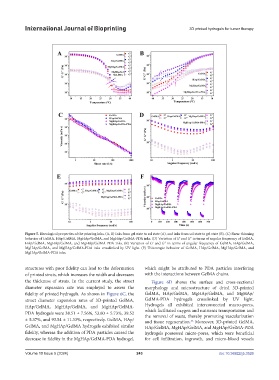Page 251 - IJB-10-5
P. 251
International Journal of Bioprinting 3D printed hydrogels for tumor therapy
Figure 5. Rheological properties of the printing inks. (A, B) Inks from gel state to sol state (A), and inks from sol state to gel state (B). (C) Shear thinning
behavior of GelMA, HAp/GelMA, MgHAp/GelMA, and MgHAp/GelMA-PDA inks. (D) Variation of Gʹ and G˝ in terms of angular frequency of GelMA,
HAp/GelMA, MgHAp/GelMA, and MgHAp/GelMA-PDA inks. (E) Variation of Gʹ and G˝ in terms of angular frequency of GelMA, HAp/GelMA,
MgHAp/GelMA, and MgHAp/GelMA-PDA inks crosslinked by UV light. (F) Thixotropic behavior of GelMA, HAp/GelMA, MgHAp/GelMA, and
MgHAp/GelMA-PDA inks.
structures with poor fidelity can lead to the deformation which might be attributed to PDA particles interfering
of printed struts, which increases the width and decreases with the interactions between GelMA chains.
the thickness of struts. In the current study, the struct Figure 6D shows the surface and cross-sectional
diameter expansion rate was employed to assess the morphology and microstructure of dried 3D-printed
fidelity of printed hydrogels. As shown in Figure 6C, the GelMA, HAp/GelMA, MgHAp/GelMA, and MgHAp/
struct diameter expansion rates of 3D-printed GelMA, GelMA-PDA hydrogels crosslinked by UV light.
HAp/GelMA, MgHAp/GelMA, and MgHAp/GelMA- Hydrogels all exhibited interconnected macro-pores,
PDA hydrogels were 38.51 ± 7.56%, 53.60 ± 5.73%, 39.52 which facilitated oxygen and nutrients transportation and
the removal of waste, thereby promoting vascularization
± 5.37%, and 93.54 ± 11.33%, respectively. GelMA, HAp/ and tissue regeneration. Moreover, 3D-printed GelMA,
55
GelMA, and MgHAp/GelMA hydrogels exhibited similar HAp/GelMA, MgHAp/GelMA, and MgHAp/GelMA-PDA
fidelity, whereas the addition of PDA particles caused the hydrogels possessed micro-pores, which were beneficial
decrease in fidelity in the MgHAp/GelMA-PDA hydrogel, for cell infiltration, ingrowth, and micro-blood vessels
Volume 10 Issue 5 (2024) 243 doi: 10.36922/ijb.3526

